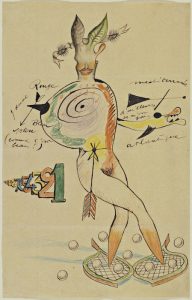 Example of ‘exquisite corpse’ drawing by Yves Tanguy, Joan Miro, Man Ray, and Max Morise, 1926-27, pencil, colored pencil and ink on paper, 35.9 x 22.9 cm. MoMA
Example of ‘exquisite corpse’ drawing by Yves Tanguy, Joan Miro, Man Ray, and Max Morise, 1926-27, pencil, colored pencil and ink on paper, 35.9 x 22.9 cm. MoMA
Surrealism
Surrealism is one of the most creative and influential art and literature movements of the 20th Century. Surrealists sought to unlock the power of the unconscious mind in a rebellion against logic, morals and the values of the bourgeois and political establishments of the 1920s and ‘30s.
Surrealism is a broad style in painting, sculpture, photography, film and fashion. For our purposes, it can be organized into two main areas. Each area uses the power of dreams, memories and the unconscious mind to explore different attitudes, states of being and experiences, with the difference between these two areas of Surrealism being in the type of images and the techniques used to make art.
Use this table (Word) to organize your notes as you read. In the table, Surrealism has been divided into two varieties or types with one column referring to ‘the oneiric’ category meaning ‘relating to dreams or dreaming’ and the other column referring to ‘automatism’ meaning the performance of actions without conscious thought or intention.
In the table (Word), keep a list of key terms and characteristics that help define and explain Surrealist artworks within these two different categories/columns. Your notes should include key ideas, influences and information related to Surrealism and to the individual artists and artworks discussed throughout.
Begin with the Met’s short essay on Surrealism:
https://www.metmuseum.org/toah/hd/surr/hd_surr.htm
Read about any or all of the artworks that accompany the Met’s essay. For the four artworks listed below, explain what specific ideas, techniques, and other Surrealist terms and concepts from the introductory essay apply specifically to each artwork by putting each one into their related column in the table:
- Joan Miró, The Potato, 1928
- Salvador Dalí, The Accommodations of Desire, 1929
- Max Ernst, The Barbarians, 1937
- Pablo Picasso, Nude Standing by the Sea, 1929
Read the Met’s essay ‘Photography and Surrealism’:
https://www.metmuseum.org/toah/hd/phsr/hd_phsr.htm
Optional: To contextualize photography in the twentieth century, read the Met’s essay ‘The New Vision of Photography’ about the role of photography in the 1920s and 1930s: https://www.metmuseum.org/toah/hd/nvis/hd_nvis.htm
On Khan Academy, in the section ‘Art between the Wars: the Avant-garde and the rise of Totalitarianism’, scroll down to Surrealism. Here is the link: https://www.khanacademy.org/humanities/art-1010/art-between-wars
Read the ‘Introduction to Surrealism’ essay, taking notes. LINK: https://www.khanacademy.org/humanities/art-history/art-1010/art-between-wars/surrealism1/a/surrealism-an-introduction
Continue to compile all the related terms, descriptions or techniques associated with each type of Surrealism into one of the columns.
In this essay, you are introduced to a game called Cadavre Exquis, which means ‘exquisite corpse’, a game played by the Surrealists.
Read this short explanation of what this game ‘exquisite corpse’ is for more information: http://www.poets.org/poetsorg/text/play-exquisite-corpse
Answer in your notes and in the table (question 1):
How did ‘Exquisite Corpse’ relate to Surrealist thinking? Why did they play it? In the table, explain how the ‘exquisite corpse’ game relates to each of the two types of Surrealism defined in the table’s columns by including a short explanation of its role in making artworks in that type of Surrealism (oneiric and/or automatism).
After the introductory essay, use menu on the left to read the following essays and watch the following videos about individual artworks. Put each artwork into one of the columns, explaining why it belongs there:
- Man Ray, The Gift: https://www.khanacademy.org/humanities/art-1010/art-between-wars/surrealism1/a/man-ray-the-gift
- Dali, The Persistence of Memory: https://www.khanacademy.org/humanities/art-1010/art-between-wars/surrealism1/v/salvador-dal-the-persistence-of-memory-1931
- Dali, Metamorphosis of Narcissus: https://www.khanacademy.org/humanities/art-1010/art-between-wars/surrealism1/v/dal-metamorphosis-of-narcissus-1937
- Giacometti, The Palace at 4am: https://www.khanacademy.org/humanities/art-1010/art-between-wars/surrealism1/v/giacometti-palace-at-4am-1932
- Meret Oppenheim, Object: https://www.khanacademy.org/humanities/art-1010/art-between-wars/surrealism1/a/meret-oppenheim-object-fur-covered-cup-saucer-and-spoon
Read through the Surrealism essay on theartstory.org to see if the information covered is similar to what you have learned from the Met and from the Khan Academy information. Link: http://www.theartstory.org/movement-surrealism.htm
(Click on individual artworks in the blue box to read more about individual works…)
Answer these questions in your notes and/or by inserting answers into the table where the information is relevant (questions 2, 3):
Explain how the subconscious relates to Surrealism. How do Sigmund Freud’s theories relate to Surrealism? How does each type of Surrealism (from the table) rely on the subconscious?
Think specifically about how some of the techniques used to make Surrealist artworks relate to the subconscious. How does the Dadaist interest in randomness and chance relate to this?
(answer at the bottom of the table or on the back – question 4):
Why do you think so many Surrealist artworks deal with the themes of sexuality or violence? How do these subjects relate to the ideas associated with Surrealism?
For class next week – summary of the 2 required things to do:
- Read and take notes on Surrealism.
- Complete the Surrealism table (Word) and answer the questions asked in the above instructions (4 separate questions). Bring the table and these short answers to class for peer-review and discussion.


